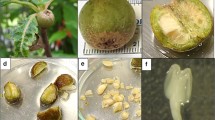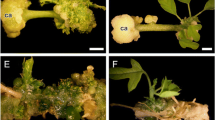Abstract
An efficient protocol for the regeneration of lavandin (Lavandula x intermedia cv. 'Grosso') is reported. Thiadazuron (9 μM), a plant growth-modulating phenylurea, was used to induce callus formation and shoot initiation from cultured leaf explants. Newly emerged shoots were maintained on media containing 0.05 μM naphthaleneacetic acid to allow maturation, and then transferred to media containing 2.9 μM indole-3-acetic acid to allow root formation. The phenolic control agents polyvinylpyrrolidone (PVP), ascorbic acid, 2-aminoindane-2-phosphonic acid, and activated charcoal were tested for their ability to prevent shoot browning and death in culture. All agents except PVP were found to be effective, with ascorbic acid being most consistent in promoting development of healthy mature shoots. The effect of light type (red light vs. white light) and culture medium composition (full- and half-strength Murashige and Skoog or Llyod and McCown’s woody plant medium (WPM)) on rooting efficiency was also evaluated. Cultures on half-strength WPM in white light were found to have the highest rooting efficiency. Additionally, application of the polyamines putrescine, spermine, and spermidine were tested for their effect on rooting. While rooting efficiency was not improved with any of the treatments, spermine and spermidine were found to have an inhibitory effect at concentrations greater than 10 μM.







Similar content being viewed by others
References
Couée I, Hummel I, Sulmon C, Gouesbet G, El Amarani A (2004) Involvement of polyamines in root development. Plant Cell Tissue Organ Cult 76:1–10
Daud N, Faizal A, Geelen D (2013) Adventitious rooting of Jatropha curcas L. is stimulated by phloroglucinol and by red LED light. In Vitro Cell Dev Biol Plant 49:183–190
Falk L, Biswas K, Boeckelmann A, Lane A, Mahmoud SS (2009) An efficient method for the micropropagation of Lavenders: regeneration of a unique mutant. J Essent Oil Res 21:225–228
Gill SS, Tuteja N (2010) Polyamines and abiotic stress tolerance in plants. Plant Signal Behav 5:26–33
Gitz DC, Liu-Gitz L, McClure JW, Huerta AJ (2004) Effects of a PAL inhibitor on phenolic accumulation and UV-B tolerance in Spirodela intermedia (Koch.). J Exp Bot 55:919–927
Hu GS, Hur YJ, Jia JM, Lee LH, Chung YS, Yi YB, Yun DJ, Park SK, Kim DH (2011) Effects of 2-aminoindan-2-phosphonic acid treatment on the accumulation of salidroside and four phenylethanoid glycosides in suspension cell culture of Cistanche deserticola. Plant Cell Rep 30:665–674
Jones AMP, Chattopadhyay A, Shukla M, Zón J, Saxena PK (2012) Inhibition of phenylpropanoid biosynthesis increases cell wall digestibility, protoplast isolation, and facilitates sustained cell division in American elm (Ulmus americana). BMC Plant Biol 12:75
Katterman FRH, Williams MD, Clay WF (1977) The influence of a strong reducing agent upon the initiation of callus from the germinating seedlings of Gossypium barbadense. Physiol Plant 40:98–100
Klejdus B, Kováčik J, Babula P (2013) PAL inhibitor evokes different responses in two Hypericum species. Plant Physiol Biochem 63:82–88
Kusano T, Yamaguchi K, Berberich T, Takahashi Y (2007) Advances in polyamine research in 2007. J Plant Res 120:345–350
Laukkanen H, Haggman H, Kontunen-Soppela S, Hohtola A (1999) Tissue browning of in vitro cultures of Scots pine: Role of peroxidase and polyphenol oxidase. Physiol Plant 106:337–343
Lloyd G, McCown B (1980) Commercially-feasible micropropagation of mountain laurel, Kalmia latifolia, by use of shoot-tip culture. Comb Proc Int Plant Prop Soc 30:421–427
Murashige T, Skoog F (1962) A revised medium for rapid growth and bio assays with tobacco tissue cultures. Physiol Plant 15:473–497
Pan MJ, Staden JV (1998) The use of charcoal in in vitro culture—a review. Plant Growth Regul 26:155–163
Ruuhola T, Julkunen-Titto R (2003) Trade-off between synthesis of salicylates and growth of micropropagated Salix pentandra. J Chem Ecol 29:1565–1588
Tang W, Newton RJ (2004) Increase of polyphenol oxidase and decrease of polyamines correlate with tissue browning in Virginia pine (Pinus virginiana Mill.). Plant Sci 167:621–628
Upson T, Andrews S (2004a) Taxonomic treatment of Lavandula. In: Lavender the genus Lavandula. Timber Press Inc., Oregon USA, pp 107–388
Upson T, Andrews S (2004b) The history of lavender cultivation. In: Lavender the genus Lavandula. Timber Press Inc., Oregon USA, pp 1–50
Zoń J, Miziak P, Amrhein N, Gancarz R (2005) Inhibitors of phenylalanine ammonia-lyase (PAL): synthesis and biological evaluation of 5-substituted 2-aminoindane-2-phosphonic acids. Chem Biodivers 2:1187–1194
Zuzarte MR, Dinis AM, Cavaleiro C, Salgueiro LR, Canhoto JM (2010) Trichomes, essential oils and in vitro propagation of Lavandula pedunculata (Lamiaceae). Ind Crop Prod 32:580–587
Acknowledgments
This work was supported through grants or in-kind contributions to Soheil Mahmoud by UBC, Natural Sciences and Engineering Research Council of Canada, Canada Foundation for Innovation, and industrial partners including Okanagan Lavender Herb Farm (Kelowna, B.C.) and Downderry Nursery Ltd (Tonbridge, UK). Financial support was also provided by the Investment Agriculture Foundation of B.C. through programs it delivers on behalf of Agriculture and Agri-Food Canada and the B.C. Ministry of Agriculture. We would like to thank Dr. Susan Murch for generously providing the AIP for this study and Broc Glover for his assistance in manuscript proof-reading.
Author information
Authors and Affiliations
Corresponding author
Additional information
Editor: John W. Forster
Rights and permissions
About this article
Cite this article
Erland, L.A.E., Mahmoud, S.S. An efficient method for regeneration of lavandin (Lavandula x intermedia cv. 'Grosso'). In Vitro Cell.Dev.Biol.-Plant 50, 646–654 (2014). https://doi.org/10.1007/s11627-014-9614-4
Received:
Accepted:
Published:
Issue Date:
DOI: https://doi.org/10.1007/s11627-014-9614-4




